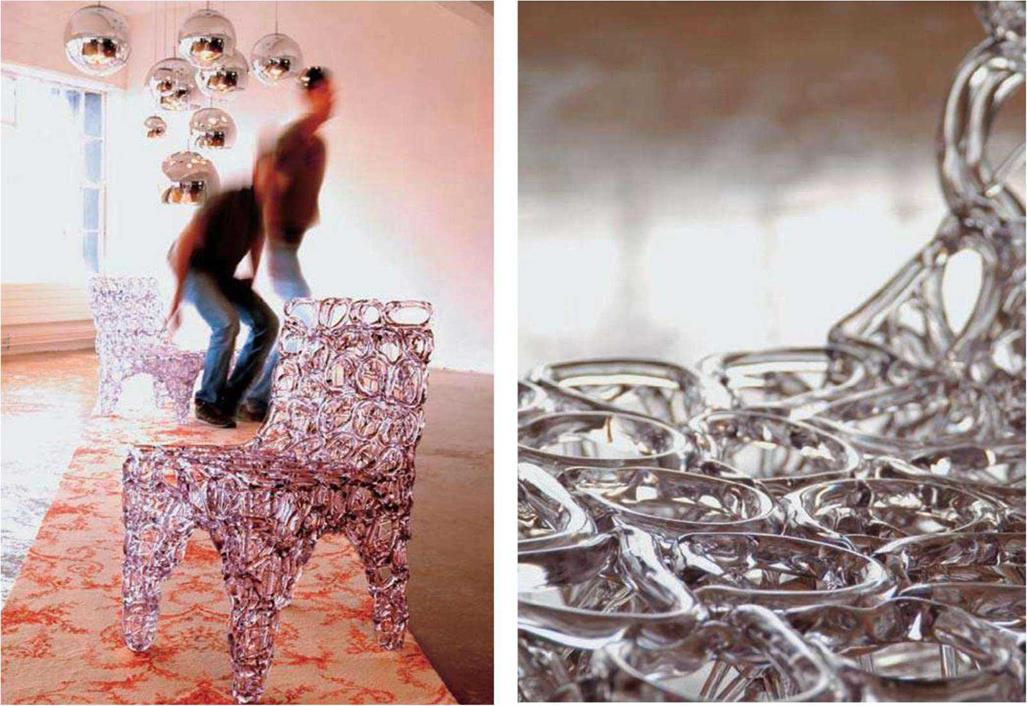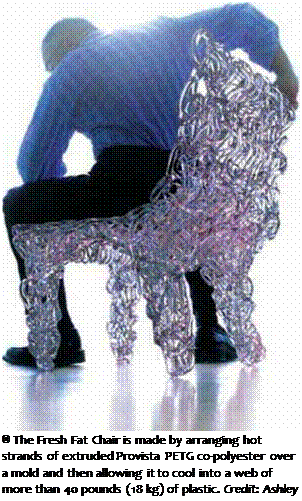 then someone else does the model and it gets sent to a manufacturing facility. This project was multidimensional.”
then someone else does the model and it gets sent to a manufacturing facility. This project was multidimensional.”
The Fresh Fat Chair—and the table and bowls—collapse all these steps into a single, spontaneous piece of design performance art. Dixon subverts the industrial process of plastic extrusion by taking the hot polymer strands as they come out of the machine and draping and weaving them over a rough mold where they cool into the shape of furniture. The Provista PETG co-polyster plastic solidifies into a glistening structure that looks as delicate as a glass house but is actually solid and stable. “They’re all individual,” says Dixon. “The makeup, or pattern, is variable according to how it comes out and according to the people who are making it. Everyone has different handwriting.”
The Fresh Fat line of furniture is the result of a competition to design a window for the upscale department store, Selfridges. Dixon says, “I actually made a small factory, which included a plastic extrusion machine that threw out hot, plastic spaghetti. There was an activity where designers were invited to come along and make unplanned objects from this stream of plastic. It was fascinating to see how people react to making an object. This project brings together craft and design. I’ve always been interested in craft and making things myself by hand or just for fun. I think this is absent from most people’s lives. Designers are facing the computer and not the actual object.” For Dixon, the immediacy of this process is a central part of its allure. “I love machinery and industrial processes but also making things by hand. There’s nothing nicer than having an idea and completing it in a day. I think in modern man, that’s impossible to achieve these days. Most people are involved in only a part of the process. There’s something really nice about seeing the completion of an object.”
Dixon also sees this way of manufacturing as a portent of things to come. “There’s a logic to this,” he explains. “My view is that shops today are where people come to buy goods. The IKEA model has been the future, where customers are forced to go to a warehouse. The next logical step is that they go to the manufacturing floor where they actually participate in the creation of the goods.” For Dixon, creating products in the way he makes the Fresh Fat furniture has distinct benefits for retailers and consumers. “I moved the factory into the retail store. The dream scenario for retailers is to hold absolutely no stock and just produce the item when the customer pays for it. You don’t over – or understock, but are just making to order. One day, you’ll be able to react only to what the customer wants instead of what you think the customer wants. This is a reflection on the future of shopping, and the ideal situation for the retailer.”
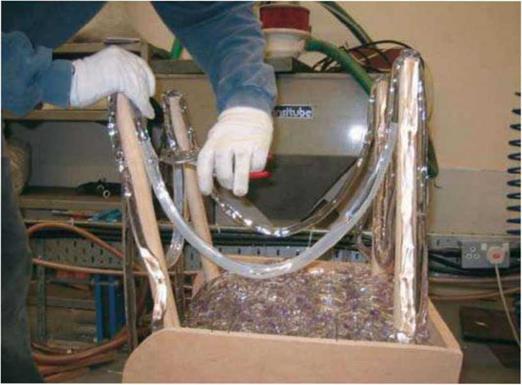
|
|
|
|
|
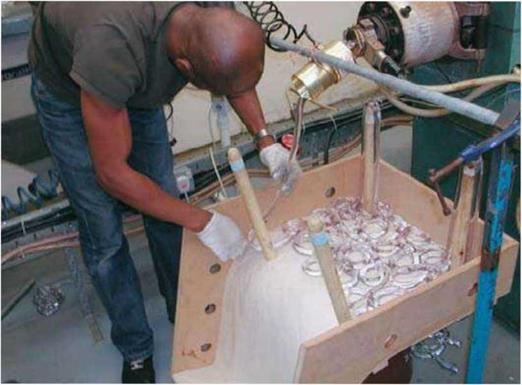

|
After the initial success at Selfridges, Dixon has taken his extrusion machine on the road and set up his unique brand of design – theater at a Renaissance church and the Victoria and Albert museum. “It’s taught me a lot about making things and the added value of objects,” he says. “It’s taught me something about the psychology of design. I will be using more industrial machines and diverting machines in my work. I think the future of design in general is to involve the customer more in the process.”
For his Fresh Fat line of furniture, he experimented with a few shapes before settling on two chairs, a table, and bowls in two sizes. “It’s been surprisingly successful considering it’s an experiment,” he notes. “People are surprised you can sit on them. At first they treat them very gingerly. They think the chair is made of glass because they’re not used to seeing plastic used in this way. They treat them with respect, but this is something incredibly tough and hard to break.”
![]()
 Which is yet another somewhat subversive pleasure for Dixon about this chair. “There’s something special about being able to use plastic,” he says. “As a young designer, you don’t really ever get the chance to make something in plastic because of the high tooling costs. And then there’s the issue of, is plastic a throw away product or not? We’re using forty to fifty pounds of plastic in the chair, which means you can’t throw it away. You’re in a position where you’ve got this thing that’s almost as heavy as you can carry, so it’s no longer disposable; it’s a precious item. The
Which is yet another somewhat subversive pleasure for Dixon about this chair. “There’s something special about being able to use plastic,” he says. “As a young designer, you don’t really ever get the chance to make something in plastic because of the high tooling costs. And then there’s the issue of, is plastic a throw away product or not? We’re using forty to fifty pounds of plastic in the chair, which means you can’t throw it away. You’re in a position where you’ve got this thing that’s almost as heavy as you can carry, so it’s no longer disposable; it’s a precious item. The
|
50 DESIGN SECRETS: FURNITURE |
|
truth is that plastic is a petrochemical, it is a precious material, and it should be treated that way,” Dixon points out. “People normally see it as a disposable material. I just try to generate larger shapes, and use the plastic in a very permanent way.”
Because the chairs are made one-by-one, Dixon can scale production up or down as needed. “This product is somewhere between industry and craft,” he notes. “It’s not a supremely practical chair. It’s very heavy. It’s not that we’re going to sell hundreds of thousands of them.” But after all, these chairs are about the quality of the process more than the end product. The Fresh Fat has even brought new pleasures to the people on the manufacturing floor at the extrusion factory. “They look on this as slightly mad in the beginning, and then they start enjoying the process a bit more,” Dixon
says. “We’ve had some great times in the factories where we’re liberating them from what becomes a very dull job watching plastic tubing come off the line.”
Or perhaps it’s just Dixon’s enthusiasm that is contagious. When asked what was most surprising about the process, he says, “It was the joy of making things again. It was seeing people who hadn’t actually made something for ages, responding to the unknown. This machine is just throwing out hot plastic that you have to manipulate with gloves. You can’t really predict what you’ll make, you can only try to form it. It’s like having a first go on the pottery wheel; it’s a little out of control. There was something so nice about the freedom and the immediacy of it.”
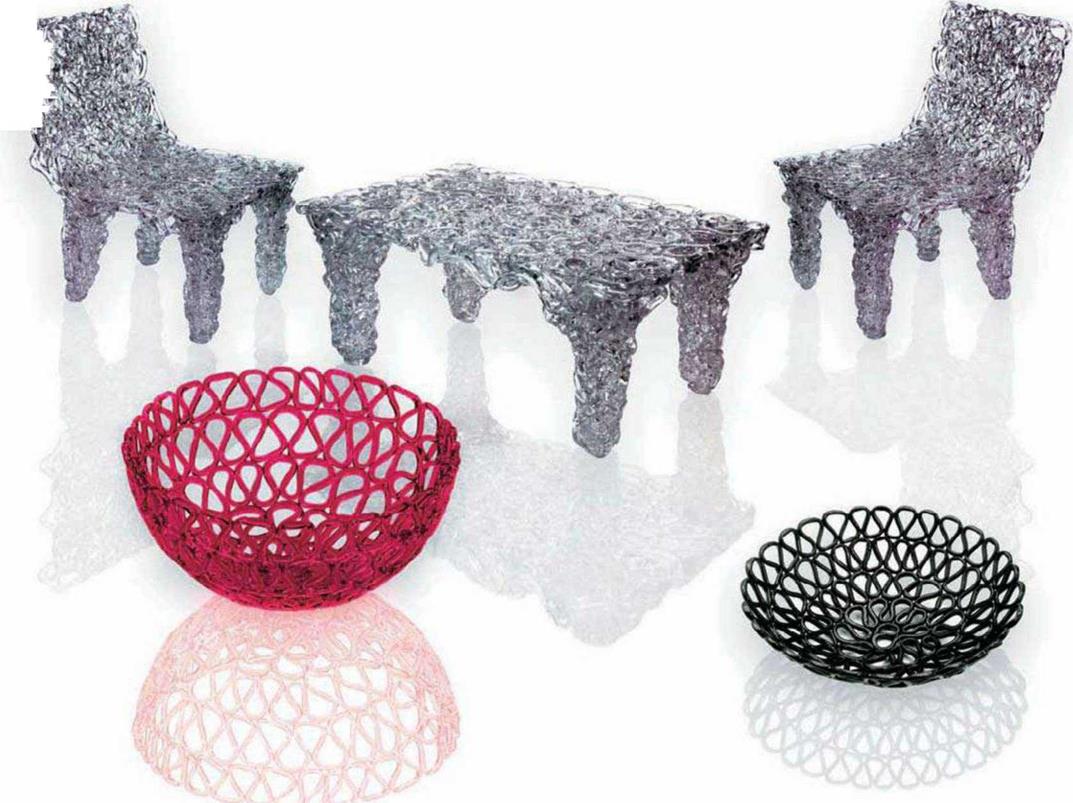
© The Fresh Fat collection includes two chairs and a coffee table in clear plastic, and two different sized bowls in clear, vivid red, or black. Credit: Gideon Hart

